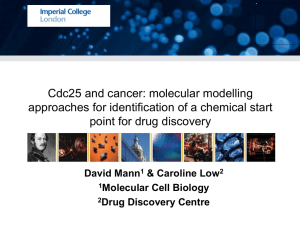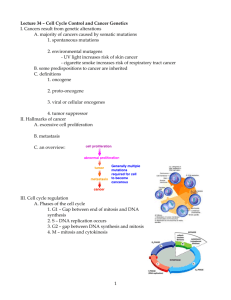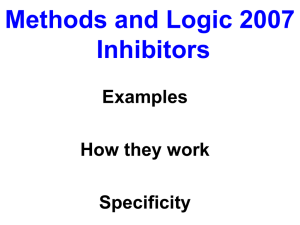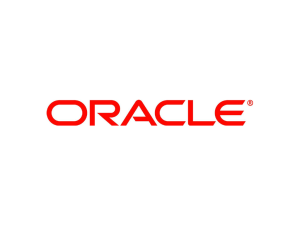Curr. Pharm. Biotechnol. 1 107
advertisement
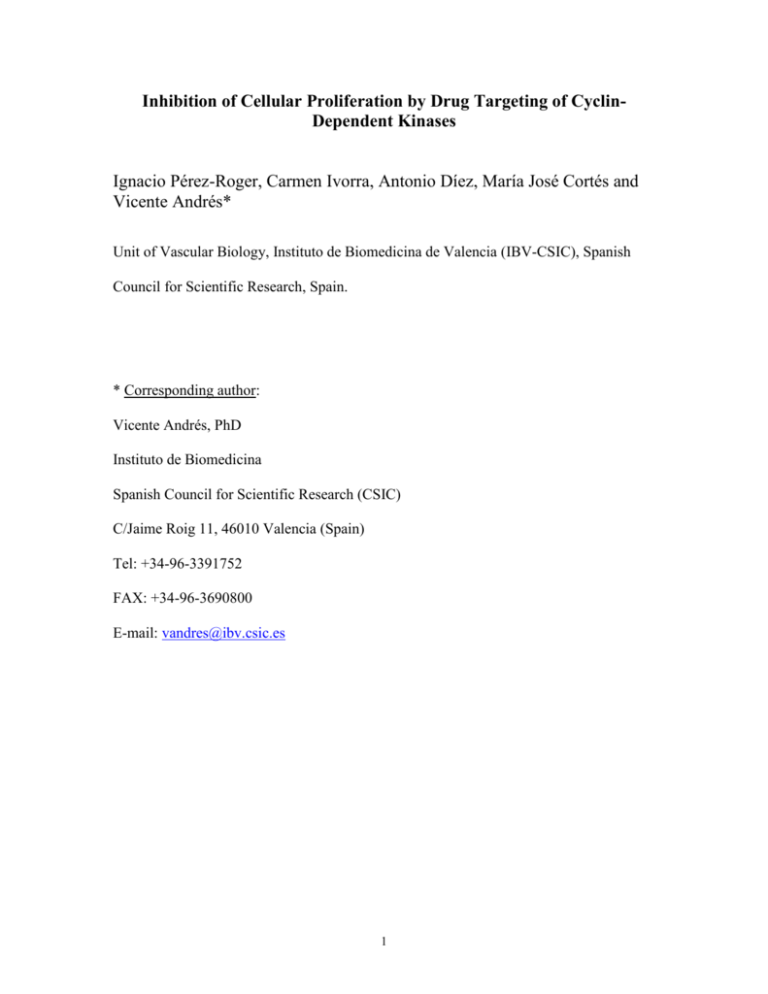
Inhibition of Cellular Proliferation by Drug Targeting of CyclinDependent Kinases Ignacio Pérez-Roger, Carmen Ivorra, Antonio Díez, María José Cortés and Vicente Andrés* Unit of Vascular Biology, Instituto de Biomedicina de Valencia (IBV-CSIC), Spanish Council for Scientific Research, Spain. * Corresponding author: Vicente Andrés, PhD Instituto de Biomedicina Spanish Council for Scientific Research (CSIC) C/Jaime Roig 11, 46010 Valencia (Spain) Tel: +34-96-3391752 FAX: +34-96-3690800 E-mail: vandres@ibv.csic.es 1 Abstract Abnormal cellular proliferation is associated with the pathology of several diseases, including cancer, atherosclerosis and restenosis post-angioplasty. Therefore, anti-proliferative therapies may be a suitable approach to treat these disorders. Candidate targets for such strategies include specific components of the cell cycle machinery. Progression through the cell cycle in mammalian cells requires the activation of several cyclin-dependent protein kinases (CDKs) through their association with regulatory subunits called cyclins. Active CDK/cyclin holoenzymes phosphorylate cellular proteins including the retinoblastoma susceptibility gene product (pRb) and the related pocket proteins p107 and p130. Several compounds have been described that directly or indirectly inhibit the activity of CDKs, which results in a suppression of cell growth. In this review, we will discuss the use of drugs targeting CDKs and their therapeutic application in animal models and clinical trials. 2 Introduction Tight control of cellular growth is essential to ensure normal tissue patterning and prevent pathological responses associated with excessive proliferation. Cell cycle progression is mediated by several CDKs that associate with regulatory subunits called cyclins [1, 2]. Different CDK/cyclin complexes are orderly activated at specific phases of the cell cycle. Active CDK/cyclin holoenzymes are presumed to hyperphosphorylate pRb and the related pocket proteins p107 and p130 from mid G1 to mitosis. The interaction among members of the E2F family of transcription factors and individual pocket proteins is a complex regulatory event that determines whether E2F proteins function as transcriptional activators or repressors [3-7]. Phosphorylation of pocket proteins is involved in the transactivation of genes with functional E2F-binding sites, including several growth and cell-cycle regulators (i.e., c-myc, pRb, p34cdc2, cyclin E, cyclin A), and genes encoding proteins that are required for nucleotide and DNA biosynthesis (i. e., DNA polymerase , histone H2A, proliferating cell nuclear antigen, thymidine kinase) [7] Vascular proliferative diseases (i. e., atherosclerosis and restenosis) and cancer are associated with excessive cell growth. The crucial role of CDK/cyclin holoenzymes in the control of cell proliferation has prompted great interest in the development of chemical inhibitors of CDK activity that would be expected to inhibit cellular proliferation and therefore may attenuate the development of vascular occlusive lesions and tumor progression. Here, we review the biological effects of synthetic CDK inhibitors on cultured cells and their activity in preclinical studies. We will also discuss agents that are presently being tested in clinical trials. For structural information on synthetic inhibitors, readers are directed to excellent reviews on this subject [8, 9]. 3 Chemical inhibitors of Cyclin-Dependent Kinases In this section, we will review the different families of synthetic CDK inhibitors (purines, alkaloids, indirubins, flavonoids, paullones, butyrolactone and hymenialdisine) and their specificity against different protein kinases. The family members and their IC 50 values against different CDKs are shown in Table I. Purines Members of this family are olomoucine, roscovitine, CVT-313, isopentenyl-adenine and purvalanol B. These compounds compete with ATP for the binding site in the cyclin/CDK complex. Results of structural analysis have shown that the purine portion of these inhibitors binds to the adenine-binding pocket of the CDK, preventing binding of its true ligand [10-12]. Purvalanol B is highly specific for CDKs, with an IC50 value of 6 nM for CDK1, 2 and 5 [12]. In contrast, the IC50 value of purvalanol B when tested against other protein kinases is higher than 10 M [12]. Both olomoucine and roscovitine are specific for CDK1, 2 and 5, but are very weak inhibitors of CDK4. The inhibitory effect of roscovitine is 10 times higher than that of olomoucine, with IC50 values around 600 nM and 7 M, respectively [13-15]. CVT-313 is highly specific for CDK2 (IC50 = 500 nM) and, to a lesser extent, for CDK1 (IC50 = 4M), but shows a very weak inhibitory effect on CDK4 (IC50 = 215 M) [16]. Isopentenyl-adenine is the weakest and less specific protein kinase inhibitor of this family, with IC50 values for CDKs higher than 40 M [14, 15, 17]. Alkaloids Alkaloids (staurosporine, UCN-01 and CGP 41 251) are broad-spectrum protein kinase inhibitors that have been used for their activity against PKC, although they can also inhibit 4 CDKs efficiently. The binding of staurosporine to CDK2 resembles that of the adenine base of ATP [18]. Staurosporine is the most potent CDK inhibitor of the alkaloid family, with IC50 values in the nM range for CDK1, 2 and 5 [14, 17, 19]. UCN-01 shows less specificity for CDK1 (IC50 = 1 M) than for other CDKs (IC50 values in the nM range), but its highest affinity is for PKC (IC50 value of 20-60 nM) [20-23]. CGP 41 251 is also a potent PKC inhibitor that shows low affinity for CDKs, with IC 50 values in the M range [24]. Indirubins Indirubin is the active ingredient of a mixture of plants used in traditional Chinese medicine to treat chronic diseases. Indirubin and its analogues are very specific inhibitors of CDKs and show very little activity against other protein kinases. The crystal structure shows that these inhibitors act by competing with ATP for binding to the ATP-binding site of CDK2 [25]. Indirubins show high inhibitory activity against CDK1, 2 and 5, and 10 times lower for CDK4. Indirubin is the least active member of the family, with IC50 values in the M range. The most potent inhibitor of this family is indirubin-5-sulphonic acid, with IC50 values between 35 nM and 300 nM. Other indirubin derivatives with strong CDK inhibitory activity are 5-chloro-indirubin and indirubin-3’-monoxime, with IC50 values between 200 nM and 800 nM for CDKs 1, 2 and 5 and around 5 M for CDK4 [25]. Flavonoids Flavopiridol and its dechloro derivative L86-8276 are relatively potent CDK inhibitors (IC50 values in the nM range). The crystal structure of a complex between CDK2 and L86-8276 shows that the aromatic portion of the inhibitor binds to the adenine-binding pocket of the CDK 5 [26]. Moreover, the position of the phenyl group enables the inhibitor to make contacts with the enzyme that are not observed in the ATP complex structure Flavopiridol shows higher specificity towards CDK4 (IC50 = 65 nM) than towards CDK1 and 2 (IC50 values of 500 nM and 100 nM, respectively); the IC50 values of flavopiridol for other protein kinases are all in the M range [27, 28]. Paullones Paullones have been discovered recently using an algorithm to detect similarities in the pattern of compound action to flavopiridol. They act as competitive inhibitors of ATP binding, and molecular modeling indicates that paullones make contacts in the ATP-binding site similar to those observed in the crystal structures of other CDK2-bound inhibitors [29]. Alsterpaullone shows a high CDK1 inhibitory activity, with an IC50 value of 35 nM [30]. Kenpaullone is less potent (IC50 = 400-800 nM) and has much less effect on other protein kinases (IC50 values in the M range) [29]. Butirolactone I Butyrolactone I is a natural compound isolated from Aspergillus which acts as an ATP binding competitor [31]. It is specific for CDK1 and 2 and does not inhibit other protein kinases. Its IC50 values for CDK1 and CDK2 are 600 nM and 1.5 M, respectively [31, 32]. Hymenialdisine Hymenialdisine is a compound which has been isolated recently from a marine sponge and which contains both bromopyrrole and guanidine groups [33]. It acts as an ATP-binding competitor and the crystal structure of the CDK2/hymenialdisine complex shows hydrogen bonds similar to the links observed in other CDK/inhibitor structures. It is a very potent inhibitor of CDKs 1, 2 and 5 (IC50 values between 22 and 70 nM). Interestingly, it shows high inhibitory 6 activity against three protein kinases presumably involved in Alzheimer’s disease, like glycogen synthase kinase-3 (GSK-3), casein kinase 1 (CK1) and CDK5, with IC50 values of 10 nM, 35 nM and 28 nM, respectively [33]. Biological effects of CDK inhibitors The biological effects of synthetic CDK inhibitors on cultured cells can be grouped in three main categories: cell cycle arrest and growth inhibition, effects on phenotypic differentiation and regulation of apoptosis. Table II summarizes the reported effects on different cell types and the concentration of the inhibitor used. In general, treatment of cells in culture with synthetic CDK inhibitors results in cell cycle arrest. The ability of most of these drugs to arrest cycling cells in the G1 and the G2 phases of the cell cycle is consistent with the fact that they can inhibit the activity of both CDK2 and CDK1 (Table II). G1 arrest in cells treated with synthetic CDK inhibitors correlates with decreased pRb protein levels and/or accumulation of hypophosphorylated pRb [22, 25, 28, 3436]. Since pRb hyperphosphorylation is thought to be mediated by CDKs [4, 37], these findings suggest that CDKs, but no other protein kinases, are the key targets of the inhibitors in these experiments. Some inhibitors, like olomoucine [38, 39], roscovitine [39] and flavopiridol [28, 40], cause the cells to arrest both in G1 and in G2 at the same concentration. Indirubin, on the other hand, has a biphasic effect, leading to G1 arrest at low doses and G2 arrest at higher concentration [25]. Similarly, human diploid lung fibroblasts undergo G1 arrest when treated with low doses of CVT-313 and both in G1 and G2 at high doses [16]. Cells treated with butirolactone I accumulate mainly in the G2 phase of the cell cycle due to its higher affinity for CDK1 [41-44]. 7 Consistent with the observation that differentiation and proliferation are mutually exclusive processes in many cell types, treatment with agents that block cell cycle progression can induce phenotypic differentiation in culture. For instance, roscovitine and flavopiridol, induce mucinous differentiation of non-small cell lung cancer cells [45]. Likewise, PC12 cells [19] and neuro2a cells [46] show neuronal differentiation when treated with staurosporine or butyrolactone I, respectively. During development and morphogenesis of multicellular organisms, physiological mechanisms of cell death are used to control cell number and as a defensive strategy to remove infected, mutated or damaged cells [47]. In many instances, programmed cell death (apoptosis) is associated with changes in CDK activity [48, 49]. While cell death can be blocked by using CDK inhibitors like butyrolactone I, olomoucine and roscovitine [50, 51], many tumor-derived cells respond to CDK inhibitor treatment with increased apoptosis (see Table II). This could be due to “conflicting” signals resulting from forced inhibition of CDKs under conditions of deregulated proliferation. Flavopiridol shows cytostatic and cytotoxic effects at the same concentration that is required in vitro for CDK inhibition (10-7 M range). CVT-313 and alkaloids are required at slightly higher concentrations on cells than with the purified enzymes in vitro, whereas 10-100 times higher concentrations of olomoucine, roscovitine, indirubins and butyrolactone I are required for cell growth suppression than those required to inhibit CDK activity in vitro (see Tables I and II). This could be due to poor permeability of these compounds or to differences in the ATP concentrations used in the in vitro experiments compared to the conditions in the cells. 8 Effects of CDK inhibitors in vivo The therapeutic application of some synthetic CDK inhibitors has been demonstrated in preclinical studies using animal models of proliferative diseases, including tumor models (i. e., xenografts in nude mice), glomerulonephritis and restenosis after angioplastia (see Table III). Akinaga et al. [52] have shown that UCN-01 has antitumor activity when administered to nude mice bearing three different human tumor xenografts (epidermoid carcinoma A431, fibrosarcoma HT1080 and acute myeloid leukemia HL-60). More recently, Kurata et al. [53] have used this drug in mice with xenografted human pancreatic tumor cells, showing that it produced significant inhibition of tumor growth during a treatment consisting in five consecutive daily intravenous injections at 9 mg/kg. This inhibitory effect continued for three days after the final administration. In the same study, using mice, rats and dogs, they showed that total clearance values of UCN-01 are high and that its concentrations in tumor tissue are higher than those found in the plasma [53]. CGP 41 251, another staurosporine derivative, prolonged the life span of mice bearing B16 melanoma, when administered at a dose of 75 mg/kg three times daily for nine days. However, it showed no effect on four kinds of murine tumor models when given orally at doses of 25-225 mg/kg once daily for nine days [54]. In subcutaneosly inoculated human tumor xenograft models, oral administration of CGP 41 251 at a dose of 200 mg/kg once daily for four weeks had a broad antitumor activity, including growth inhibition of gastric cancer H-55, colorectal cancer H-26, breast cancer H-31, lung cancer H-74 and lung cancer LC-376 [54]. Flavopiridol has been used in different human xenografted tumors, including head and neck squamous cell carcinoma (HNSCC) [55], colon carcinoma [56], prostate cancer [57] and leukemia and lymphoma xenografts [58]. Treatment of mice bearing HNSCC xenografts with 9 flavopiridol given as a daily intraperitoneal injection for five consecutive days at a concentration of 5 mg/kg, resulted in a 23 % reduction in tumor growth, reaching a 60 % reduction ten weeks after the end of the treatment [55]. In this study, it was shown that flavopiridol also induces tumor cells to undergo apoptosis [55]. Human tumors of lymphohematopoietic origin, including HL-60 and SUDHL-4 subcutaneous xenografts and Nalm/6 and AS283 disseminated disease models, also showed regression when flavopiridol was intravenously injected into mice at a concentration of 7.5 mg/kg [58]. In addition to inducing apoptosis in these tumor models, flavopiridol also had a marked proapoptotic effect on normal lymphoid organs, such as spleen, thymus and intestinal lymphoid tissues, when administered into normal animals [58]. Glomerular disease is a major cause of end-stage kidney disease. In glomerulonephritis, injury to the mesangial cells results in their proliferation, which in turn is linked with mesangial matrix expansion. Pippin et al. have used roscovitine in rats with Thy1-induced glomerulonephritis [59]. Rats treated with roscovitine (2.8 mg/kg, given as intraperitoneal injections) disclosed reduced mesangial cell proliferation, both in the prevention and in the treatment groups. At this concentration of roscovitine, rats appeared healthy, did not loose weight and did not develop peritonitis, ascites or diarrhea. Roscovitine-dependent inhibition of CDK2 activity also reduced matrix production and was associated with better renal function compared to controls [59]. Smooth muscle cell (SMC) proliferation is a common feature of vascular injury, which culminates in clinical events such as restenosis. Two CDK inhibitors, CVT-313 [16] and flavopiridol [60], have been used in a rat carotid model of restenosis after balloon angioplasty. Exposure of the denuded carotid artery at the time of inflicting the injury to CVT-313 at a dose of 1.25 mg/kg for 15 minutes under pressure reduced neointimal lesion formation by 80 % [16]. 10 Flavopiridol at 5 mg/kg administered orally for five days beginning at the day of injury reduced neointima formation by 35 % and by 39 % at day seven and fourteen after injury, respectively [60]. Clinical applications of synthetic CDK inhibitors Indirubin, an active ingredient of a traditional Chinese recipe given to patients with chronic myelocytic leukemia, is the first example of a CDK inhibitor being used to treat human cancer [25]. Other CDK inhibitors, flavopiridol [61-63] and UCN-01 [64, 65] are currently undergoing phase I clinical trials after their successful use in animal models. Flavopiridol has been given to patients with refractory malignancies as a 72-hour infusion every two weeks [62]. Concentrations of flavopiridol needed for CDK inhibition in preclinical models were achieved safely in humans. In this study, one partial response in a patient with renal cancer and minor responses in three patients with non-Hodgkin’s lymphoma and colon and renal cancer have been reported [62]. Administration of UCN-01 as a 72-hour infusion to cancer patients showed that this drug is well tolerated in humans at high concentrations (2-3 M) and that it has an unusual and unpredicted long half-life [64, 65]. The low distribution volumes and systemic clearance values of UCN-01 in humans, which are in contrast with the results in experimental animals [53], could be due to its specifically high binding to 1-acid glycoprotein [64]. In the treatment of cancer, some CDK inhibitors may be very useful not only in preventing proliferation of tumor cells but also in inhibiting the growth of the tumor itself by acting as anti-angiogenic agents. One example is flavopiridol, which decreased blood vessel formation in a mouse Matrigel model of angiogenesis [56]. 11 Another potential use of CDK inhibitors is in preventing clinical restenosis after ballon angioplasty. In an animal model of balloon denudation, flavopiridol was active when given orally [60], which makes it a promising candidate to study the benefits of cell cycle inhibition to prevent human restenosis. CDKs may also play an important role in Alzheimer’s disease. In particular, CDK5 is involved in the phosphorylation of tau protein [66]. Three CDK inhibitors, purvalanol B [12], staurosporine [14] and hymenialdisine [33], have low IC50 values for CDK5 (less than 30 nM). Hymenialdisine not only inhibits CDK5 but also GSK-3, the other protein kinase that plays a role in the phosphorylation of substrates involved in Alzheimer’s disease [33]. These unusual properties make hymenialdisine a promising compound in the treatment of neurodegenerative disorders. In summary, synthetic CDK inhibitors are potent inhibitors of cell cycle progression that can be used to treat proliferative disorders. CDK inhibitors may be very useful as anti tumor drugs, either alone or as part of combined therapies. Structural studies of inhibitors/CDK complexes should help develop new CDK inhibitors with higher biological specificity and activity. 12 References 1. Morgan, D. O. (1995) Nature 374, 131-134. 2. Nurse, P. (1994) Cell 79, 547-550. 3. Helin, K. & Harlow, E. (1993) Trends Cell Biol. 3, 43-46. 4. Weinberg, R. A. (1995) Cell 81, 323-330. 5. Mayol, X. & Graña, X. (1998) Front. Biosci. 3, 11-24. 6. Dyson, N. (1998) Genes Dev 12, 2245-62. 7. Lavia, P. & Jansen-Durr, P. (1999) Bioessays 21, 221-30. 8. Gray, N., Detivaud, L., Doerig, C. & Meijer, L. (1999) Curr Med Chem 6, 859-875. 9. Meijer, L. (1996) Trends in Cell Biology 6, 393-397. 10. Schulze-Gahmen, U., Brandsen, J., Jones, H. D., Morgan, D. O., Meijer, L., Vesely, J. & Kim, S. H. (1995) Proteins 22, 378-91. 11. De Azevedo, W. F., Leclerc, S., Meijer, L., Havlicek, L., Strnad, M. & Kim, S. H. (1997) Eur J Biochem 243, 518-26. 12. Gray, N. S., Wodicka, L., Thunnissen, A. M., Norman, T. C., Kwon, S., Espinoza, F. H., Morgan, D. O., Barnes, G., LeClerc, S., Meijer, L., Kim, S. H., Lockhart, D. J. & Schultz, P. G. (1998) Science 281, 533-8. 13. Meijer, L., Borgne, A., Mulner, O., Chong, J. P., Blow, J. J., Inagaki, N., Inagaki, M., Delcros, J. G. & Moulinoux, J. P. (1997) Eur J Biochem 243, 527-36. 14. Veeranna, Shetty, K. T., Amin, N., Grant, P., Albers, R. W. & Pant, H. C. (1996) Neurochem Res 21, 629-36. 15. Vesely, J., Havlicek, L., Strnad, M., Blow, J. J., Donella-Deana, A., Pinna, L., Letham, 13 D. S., Kato, J., Detivaud, L., Leclerc, S. & et al. (1994) Eur J Biochem 224, 771-86. 16. Brooks, E. E., Gray, N. S., Joly, A., Kerwar, S. S., Lum, R., Mackman, R. L., Norman, T. C., Rosete, J., Rowe, M., Schow, S. R., Schultz, P. G., Wang, X., Wick, M. M. & Shiffman, D. (1997) J Biol Chem 272, 29207-11. 17. Rialet, V. & Meijer, L. (1991) Anticancer Res 11, 1581-90. 18. Lawrie, A. M., Noble, M. E., Tunnah, P., Brown, N. R., Johnson, L. N. & Endicott, J. A. (1997) Nat Struct Biol 4, 796-801. 19. Gollapudi, L. & Neet, K. E. (1997) J Neurosci Res 49, 461-74. 20. Wang, Q., Worland, P. J., Clark, J. L., Carlson, B. A. & Sausville, E. A. (1995) Cell Growth Differ 6, 927-36. 21. Akiyama, T., Yoshida, T., Tsujita, T., Shimizu, M., Mizukami, T., Okabe, M. & Akinaga, S. (1997) Cancer Res 57, 1495-501. 22. Kawakami, K., Futami, H., Takahara, J. & Yamaguchi, K. (1996) Biochem Biophys Res Commun 219, 778-83. 23. Pollack, I. F., Kawecki, S. & Lazo, J. S. (1996) J Neurosurg 84, 1024-32. 24. Begemann, M., Kashimawo, S. A., Heitjan, D. F., Schiff, P. B., Bruce, J. N. & Weinstein, I. B. (1998) Anticancer Res 18, 2275-82. 25. Hoessel, R., Leclerc, S., Endicott, J. A., Nobel, M. E., Lawrie, A., Tunnah, P., Leost, M., Damiens, E., Marie, D., Marko, D., Niederberger, E., Tang, W., Eisenbrand, G. & Meijer, L. (1999) Nat Cell Biol 1, 60-7. 26. De Azevedo, W. F., Jr., Mueller-Dieckmann, H. J., Schulze-Gahmen, U., Worland, P. J., Sausville, E. & Kim, S. H. (1996) Proc Natl Acad Sci U S A 93, 2735-40. 27. Losiewicz, M. D., Carlson, B. A., Kaur, G., Sausville, E. A. & Worland, P. J. (1994) 14 Biochem Biophys Res Commun 201, 589-95. 28. Carlson, B. A., Dubay, M. M., Sausville, E. A., Brizuela, L. & Worland, P. J. (1996) Cancer Res 56, 2973-8. 29. Zaharevitz, D. W., Gussio, R., Leost, M., Senderowicz, A. M., Lahusen, T., Kunick, C., Meijer, L. & Sausville, E. A. (1999) Cancer Res 59, 2566-9. 30. Schultz, C., Link, A., Leost, M., Zaharevitz, D. W., Gussio, R., Sausville, E. A., Meijer, L. & Kunick, C. (1999) J Med Chem 42, 2909-2919. 31. Kitagawa, M., Okabe, T., Ogino, H., Matsumoto, H., Suzuki-Takahashi, I., Kokubo, T., Higashi, H., Saitoh, S., Taya, Y., Yasuda, H. & et al. (1993) Oncogene 8, 2425-32. 32. Someya, A., Tanaka, N. & Okuyama, A. (1994) Biochem Biophys Res Commun 198, 536-45. 33. Meijer, L., Thunnissen, A.-M., White, A., Garnier, M., Nikolic, M., Tsai, L.-H., Walter, J., Cleverley, K., Salinas, P., Wu, Y.-Z., Biernat, J., Mandelkow, E.-M., Kim, S.-H. & Pettit, G. (1999) Chemistry & Biology 7, 51-63. 34. Schrump, D. S., Matthews, W., Chen, G. A., Mixon, A. & Altorki, N. K. (1998) Clin Cancer Res 4, 2885-90. 35. Akiyama, T., Shimizu, M., Okabe, M., Tamaoki, T. & Akinaga, S. (1999) Anticancer Drugs 10, 67-78. 36. Shimizu, E., Zhao, M. R., Nakanishi, H., Yamamoto, A., Yoshida, S., Takada, M., Ogura, T. & Sone, S. (1996) Oncology 53, 494-504. 37. Graña, X. & Reddy, E. P. (1995) Oncogene 11, 211-219. 38. Abraham, R. T., Acquarone, M., Andersen, A., Asensi, A., Belle, R., Berger, F., Bergounioux, C., Brunn, G., Buquet-Fagot, C., Fagot, D. & et al. (1995) Biol Cell 83, 105-20. 15 39. Schutte, B., Nieland, L., van Engeland, M., Henfling, M. E., Meijer, L. & Ramaekers, F. C. (1997) Exp Cell Res 236, 4-15. 40. Kaur, G., Stetler-Stevenson, M., Sebers, S., Worland, P., Sedlacek, H., Myers, C., Czech, J., Naik, R. & Sausville, E. (1992) J Natl Cancer Inst 84, 1736-40. 41. Hida, D., Nakata, K., Shima, Y., Migita, K., Nakao, K., Kato, Y., Ishii, N. & Eguchi, K. (1998) Anticancer Res 18, 4317-22. 42. Nishio, K., Ishida, T., Arioka, H., Kurokawa, H., Fukuoka, K., Nomoto, T., Fukumoto, H., Yokote, H. & Saijo, N. (1996) Anticancer Res 16, 3387-95. 43. Kitagawa, M., Higashi, H., Takahashi, I. S., Okabe, T., Ogino, H., Taya, Y., Hishimura, S. & Okuyama, A. (1994) Oncogene 9, 2549-57. 44. Suzuki, M., Hosaka, Y., Matsushima, H., Goto, T., Kitamura, T. & Kawabe, K. (1999) Cancer Lett 138, 121-30. 45. Lee, H. R., Chang, T. H., Tebalt, M. J., 3rd, Senderowicz, A. M. & Szabo, E. (1999) Int J Oncol 15, 161-6. 46. Inokoshi, J., Katagiri, M., Arima, S., Tanaka, H., Hayashi, M., Kim, Y. B., Furumai, R., Yoshida, M., Horinouchi, S. & Omura, S. (1999) Biochem Biophys Res Commun 256, 372-6. 47. Vaux, D. L. & Korsmeyer, S. J. (1999) Cell 96, 245-54. 48. Gil-Gomez, G., Berns, A. & Brady, H. J. (1998) Embo J 17, 7209-18. 49. Harvey, K. J., Blomquist, J. F. & Ucker, D. S. (1998) Mol Cell Biol 18, 2912-22. 50. Furukawa, Y., Iwase, S., Terui, Y., Kikuchi, J., Sakai, T., Nakamura, M., Kitagawa, S. & Kitagawa, M. (1996) J Biol Chem 271, 28469-77. 51. Maas, J. W., Jr., Horstmann, S., Borasio, G. D., Anneser, J. M., Shooter, E. M. & Kahle, P. J. (1998) J Neurochem 70, 1401-10. 16 52. Akinaga, S., Gomi, K., Morimoto, M., Tamaoki, T. & Okabe, M. (1991) Cancer Res 51, 4888-92. 53. Kurata, N., Kuwabara, T., Tanii, H., Fuse, E., Akiyama, T., Akinaga, S., Kobayashi, H., Yamaguchi, K. & Kobayashi, S. (1999) Cancer Chemother Pharmacol 44, 12-8. 54. Ikegami, Y., Yano, S., Nakao, K., Fujita, F., Fujita, M., Sakamoto, Y., Murata, N. & Isowa, K. (1995) Arzneimittelforschung 45, 1225-30. 55. Patel, V., Senderowicz, A. M., Pinto, D., Jr., Igishi, T., Raffeld, M., Quintanilla- Martinez, L., Ensley, J. F., Sausville, E. A. & Gutkind, J. S. (1998) J Clin Invest 102, 1674-81. 56. Kerr, J. S., Wexler, R. S., Mousa, S. A., Robinson, C. S., Wexler, E. J., Mohamed, S., Voss, M. E., Devenny, J. J., Czerniak, P. M., Gudzelak, A., Jr. & Slee, A. M. (1999) Anticancer Res 19, 959-68. 57. Drees, M., Dengler, W. A., Roth, T., Labonte, H., Mayo, J., Malspeis, L., Grever, M., Sausville, E. A. & Fiebig, H. H. (1997) Clin Cancer Res 3, 273-9. 58. Arguello, F., Alexander, M., Sterry, J. A., Tudor, G., Smith, E. M., Kalavar, N. T., Greene, J. F., Jr., Koss, W., Morgan, C. D., Stinson, S. F., Siford, T. J., Alvord, W. G., Klabansky, R. L. & Sausville, E. A. (1998) Blood 91, 2482-90. 59. Pippin, J. W., Qu, Q., Meijer, L. & Shankland, S. J. (1997) J Clin Invest 100, 2512-20. 60. Ruef, J., Meshel, A. S., Hu, Z. Y., Horaist, C., Ballinger, C. A., Thompson, L. J., Subbarao, V. D., Dumont, J. A. & Patterson, C. (1999) Circulation 100, 659-665. 61. Senderowicz, A. M. (1999) Invest New Drugs 17, 313-20. 62. Senderowicz, A. M., Headlee, D., Stinson, S. F., Lush, R. M., Kalil, N., Villalba, L., Hill, K., Steinberg, S. M., Figg, W. D., Tompkins, A., Arbuck, S. G. & Sausville, E. A. (1998) J Clin Oncol 16, 2986-99. 17 63. Stinson, S. F., Hill, K., Siford, T. J., Phillips, L. R. & Daw, T. W. (1998) Cancer Chemoter Pharmacol 42, 261-5. 64. Fuse, E., Tanii, H., Kurata, N., Kobayashi, H., Shimada, Y., Tamura, T., Sasaki, Y., Tanigawara, Y., Lush, R. D., Headlee, D., Figg, W. D., Arbuck, S. G., Senderowicz, A. M., Sausville, E. A., Akinaga, S., Kuwabara, T. & Kobayashi, S. (1998) Cancer Res 58, 3248-53. 65. Sausville, E. A., Lush, R. D., Headlee, D., Smith, A. C., Figg, W. D., Arbuck, S. G., Senderowicz, A. M., Fuse, E., Tanii, H., Kuwabara, T. & Kobayashi, S. (1998) Cancer Chemother Pharmacol 42, S54-9. 66. Mandelkow, E. M. & Mandelkow, E. (1998) Trends Cell Biol 8, 425-7. 67. Iseki, H., Ko, T. C., Xue, X. Y., Seapan, A., Hellmich, M. R. & Townsend, C. M., Jr. (1997) Surgery 122, 187-94; discussion 194-5. 68. Iseki, H., Ko, T. C., Xue, X. Y., Seapan, A. & Townsend, C. M., Jr. (1998) J Gastrointest Surg 2, 36-43. 69. Mgbonyebi, O. P., Russo, J. & Russo, I. H. (1998) Anticancer Res 18, 751-5. 70. Mgbonyebi, O. P., Russo, J. & Russo, I. H. (1999) Cancer Res 59, 1903-10. 71. Yakisich, J. S., Boethius, J., Lindblom, I. O., Wallstedt, L., Vargas, V. I., Siden, A. & Cruz, M. H. (1999) Neuroreport 10, 2563-7. 72. Traganos, F., Gong, J., Ardelt, B. & Darzynkiewicz, Z. (1994) J Cell Physiol 158, 535- 44. 73. Seynaeve, C. M., Stetler-Stevenson, M., Sebers, S., Kaur, G., Sausville, E. A. & Worland, P. J. (1993) Cancer Res 53, 2081-6. 74. Nieves-Neira, W. & Pommier, Y. (1999) Int J Cancer 82, 396-404. 75. Shao, R. G., Shimizu, T. & Pommier, Y. (1997) Exp Cell Res 234, 388-97. 18 76. Bredel, M., Pollack, I. F., Freund, J. M., Rusnak, J. & Lazo, J. S. (1999) J Neurooncol 41, 9-20. 77. Chien, M., Astumian, M., Liebowitz, D., Rinker-Schaeffer, C. & Stadler, W. M. (1999) Cancer Chemother Pharmacol 44, 81-7. 78. Shapiro, G. I., Koestner, D. A., Matranga, C. B. & Rollins, B. J. (1999) Clin Cancer Res 5, 2925-38. 79. Bible, K. C. & Kaufmann, S. H. (1996) Cancer Res 56, 4856-61. 80. Konig, A., Schwartz, G. K., Mohammad, R. M., Al-Katib, A. & Gabrilove, J. L. (1997) Blood 90, 4307-12. 81. Byrd, J. C., Shinn, C., Waselenko, J. K., Fuchs, E. J., Lehman, T. A., Nguyen, P. L., Flinn, I. W., Diehl, L. F., Sausville, E. & Grever, M. R. (1998) Blood 92, 3804-16. 82. Parker, B. W., Kaur, G., Nieves-Neira, W., Taimi, M., Kohlhagen, G., Shimizu, T., Losiewicz, M. D., Pommier, Y., Sausville, E. A. & Senderowicz, A. M. (1998) Blood 91, 45865. 83. Yamamoto, H., Monden, T., Miyoshi, H., Izawa, H., Ikeda, K., Tsujie, M., Ohnishi, T., Sekimoto, M., Tomita, N. & Monden, M. (1998) Int J Oncol 13, 233-9. 84. Wada, M., Hosotani, R., Lee, J. U., Doi, R., Koshiba, T., Fujimoto, K., Miyamoto, Y., Tsuji, S., Nakajima, S., Okuyama, A. & Imamura, M. (1998) Anticancer Res 18, 2559-66. 19 Table I: Inhibition of CDK activity by chemical compounds: The IC50 values for each compound are shown. References are in parenthesis. CDK1 CDK2 CDK4 CDK5 OTHERS PURINES Olomoucine 7 M [15] 7 M [15] >1 mM [15] 8 M [14, 15] ERK1=25 M [15] Roscovitine 650 nM [13] 700 nM [13] >100 M [13] 200 nM [13] ERK1=34 M [13] ERK2=14 M [13] CVT-313 4 M [16] 500 nM [16] 215 M [16] Isopentenyl-adenine 40 M [15, 17] 50 M [15] 80 M [14, 15] CDK6>100 M [15] PKC=43-100 M [15] 6 nM [12] OTHERS>10 M [12] Purvalanol B ALKALOIDS 200 M [15] 6 nM [12] 6 nM [12] Staurosporine 20 nM [19] 3.2 nM [17] 75 nM [19] UCN-01 1 M [20] 600 nM [20, 21] 42 nM [22] 32 nM [22] CGP 41 251 INDIRUBINS 1 M [24] 1 M [24] Indirubin 10 M [25] 2.2-7.5 M [25] 12 M [25] 5.5 M [25] 5-Chloro indirubin 400 nM [25] 750-550 nM [25] 6.5 M [25] 800 nM [25] Indirubin-3’-monoxime 180 nM [25] 440-250 nM [25] 3.33 M [25] 100 nM [25] Indirubin-5-sulphonic acid FLAVONOIDS 55 nM [25] 35-150 nM [25] 300 nM [25] 65 nM [25] Flavopiridol PAULLONES 500 nM [27] 100 nM [28] 65 nM [28] Kenpaullone 400 nM [29] 680 nM [29] Alsterpaullone 35 nM [30] BUTYROLACTONE I HYMENIALDISINE 600 nM [32] 22 nM [33] 1.5 M [31] 40-70 nM [33] 600 nM [33] 20 39 nM [14] CDK6=58 nM [22] PKC=20-60 nM [23] 850 nM [29] ERK2>ERK1 [29] 28 nM [33] GSK3-=10 nM CK1=35 nM [33] Table II: Biological effects of CDK inhibitors: References are in parenthesis COMPOUND CELL TYPE EFFECT IC50 VALUES Olomoucine Human tumor cell lines Breast carcinoma Gastric cancer Pancreatic carcinoma Non-small cell lung cancer Neuroblastoma Mammalian cell lines Breast carcinoma Gastric cancer Pancreatic carcinoma Non-small cell lung cancer Neuroblastoma Resected human glioma Human diploid fibroblasts Human diploid fibroblasts Mouse, rat, and human cells in culture Non-small cell lung cancer Small cell lung cancer Epidermoid carcinoma Lymphocytic leukemia PC12 cells Breast carcinoma Colon carcinoma Non-small cell lung cancer Small cell lung cancer Lung adenocarcinoma Epidermoid carcinoma Myeloblastic leukemia T lymphoblasts Glioma Epidermoid carcinoma Glioblastoma and gliosarcoma Hematopoietic Hematopoietic Breast carcinoma Esophageal adenocarcinoma Bladder cancer Non-small cell lung cancer Lung carcinoma Epidermoid carcinoma B-prolymphocytic, B-CLL HNSC carcinoma Hematopoietic Small and non-small cell lung cancer Colon carcinoma Pancreatic cancer Human prostate cancer Human hepatoma Neuro 2a cells WI38 G1/S and G2/M block [15] Growth inhibition [38] G2/M block [67] Growth inhibition [68] G1/S-G2/M block, apoptosis [38, 39] G1/S-G2/M block, apoptosis [39] G1 and G2 arrest [13] Growth inhibition, apoptosis [69, 70] G2/M block [67] Growth inhibition [68] G1/S-G2/M block, apoptosis [39], differentiation [45] G1/S-G2/M block, apoptosis [39] DNA synthesis inhibition [71] G1/S block [16] G1/S and G2/M block [16] Growth inhibition [16] Apoptosis [36] G1 arrest [36] G2/M block [35] Tetraploidy [72] Growth inhibition, differentiation [19] G1/S block [73], Apoptosis [74] Apoptosis [75] G2 arrest [36] G2 arrest [36] G1/S block [22] G1 arrest [21, 35] Apoptosis [75] Growth inhibition, apoptosis [20] Growth inhibition, apoptosis [23, 76] Poliploidy [35] G2/M block [24] G1 arrest [25] G2 arrest [25] G1 and G2 arrest [28, 40] Growth inhibition [34] G2/M block [77] Apoptosis [78, 79], differentiation [45] Growth inhibition [40] Growth inhibition [34] Growth inhibition, apoptosis [80, 81] Growth inhibition, apoptosis [55] Apoptosis [82] G2/M block [42] Growth inhibition, apoptosis [83] Apoptosis [84] G2/M block [44] G2/M block [41] G1 arrest, differentiation [46] G1/S and G2/M block [43] 60 M 25 M Roscovitine CVT-313 Staurosporine UCN-01 CGP 41 251 Indirubin-3’-monoxime Flavopiridol Butyrolactone I 21 50-200 M 200 M 16 M 40 M 40 M 100 M 6.25 M 12.5 M 1.25-20 M 600 nM 30-60 nM 100 nM 30-100 nM 2 M 200-700 nM 40-100 nM 260-520 nM 20-65 nM 20-100 nM 5-10 M >10 M 200-300 nM 100-150 nM 250-300 nM 25-160 nM 100-150 nM 100-400 nM 43-83 nM 1 M 120 M 100 M 70-100M 23.6M Table III: Use of CDK inhibitors in animal models of disease. References are in parenthesis COMPOUND Roscovitine CVT-313 UCN-01 CGP 41 251 Indirubin Flavopiridol EXPERIMENTAL MODEL Glomerulonepritis [59] Restenosis (rat carotid artery) [16] Epidermoid carcinoma xenograft [52] Fibrosarcoma xenograft [52] Acute myeloid leukemia xenograft [52] Pancreatic tumor xenograft [53] Glioma xenograft [23] Murine fibrosarcoma [52] Gastric, colorectal, breast and lung cancer xenografts [54] Murine melanoma [54] DOSE 2.8 mg/kg (daily) 1.25 mg/kg 5 mg/kg 7 mg/kg 7 mg/kg 9 mg/kg 1-2 mg/kg (daily) 7.5 mg/kg 200 mg/kg (daily) 75 mg/kg (three times daily) Murine sarcoma [25] Head and neck squamous cell carcinoma xenograft [55] Colon carcinoma xenograft [56] Prostate cancer xenograft [57] Leukemia and lymphoma xenograft [58] Restenosis (rat carotid artery) [60] Mouse Matrigel model of angiogenesis [56] 5 mg/kg (daily) 5 mg/kg (every other day) 10 mg/kg (daily) 7.5 mg/kg (daily) 5 mg/kg (daily) 18 g.kg (daily) 22
